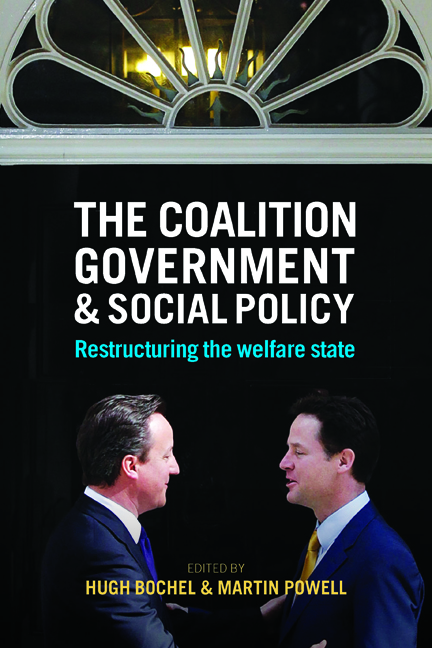Book contents
- Frontmatter
- Contents
- Notes on contributors
- One The transformation of the welfare state? The Conservative–Liberal Democrat coalition government and social policy
- Two The coalition government, public spending and social policy
- Three The changing governance of social policy
- Four The coalition, social policy and public opinion
- Five Health policy and the coalition government
- Six The coalition government, the general election and the policy ratchet in education: a reflection on the ‘ghosts’ of policy past, present and yet to come
- Seven Coalition housing policy in England
- Eight Social security under the coalition and Conservatives: shredding the system for people of working age; privileging pensioners
- Nine Welfare and active labour market policies in the UK: the coalition government approach
- Ten ‘It ain’t what you do, it’s the way that you do it’: adult social care under the coalition
- Eleven Family policy: the Mods and Rockers
- Twelve One step forward, two steps back: children, young people and the Conservative–Liberal Democrat coalition
- Thirteen The coalition and criminal justice
- Fourteen Equalities: the impact of welfare reform and austerity by gender, disability and age
- Fifteen Social policy, the devolved administrations and the UK coalition government
- Sixteen Conclusions
- Index
One - The transformation of the welfare state? The Conservative–Liberal Democrat coalition government and social policy
Published online by Cambridge University Press: 01 September 2022
- Frontmatter
- Contents
- Notes on contributors
- One The transformation of the welfare state? The Conservative–Liberal Democrat coalition government and social policy
- Two The coalition government, public spending and social policy
- Three The changing governance of social policy
- Four The coalition, social policy and public opinion
- Five Health policy and the coalition government
- Six The coalition government, the general election and the policy ratchet in education: a reflection on the ‘ghosts’ of policy past, present and yet to come
- Seven Coalition housing policy in England
- Eight Social security under the coalition and Conservatives: shredding the system for people of working age; privileging pensioners
- Nine Welfare and active labour market policies in the UK: the coalition government approach
- Ten ‘It ain’t what you do, it’s the way that you do it’: adult social care under the coalition
- Eleven Family policy: the Mods and Rockers
- Twelve One step forward, two steps back: children, young people and the Conservative–Liberal Democrat coalition
- Thirteen The coalition and criminal justice
- Fourteen Equalities: the impact of welfare reform and austerity by gender, disability and age
- Fifteen Social policy, the devolved administrations and the UK coalition government
- Sixteen Conclusions
- Index
Summary
Introduction
This chapter considers the coalition government, and the relationship between the two coalition parties and their policies. It identifies the key themes underpinning developments in social policy, and highlights some of the implications of those developments for the Conservative government elected in 2015.
It addresses the following issues:
• to what extent was the coalition government similar to and different from Conservative governments of 1979 to 1997;
• how significantly and in what ways did the policies and approaches of the coalition government differ from those of the Labour governments of 1997 to 2010;
• in what ways did the Liberal Democrats influence the coalition government's social policies;
• what underlying themes can be identified in the coalition government's social policies; and
• what were the implications of the 2010–15 coalition government for social policy.
It begins by providing a broad review of the coalition government's approach to social policy. It traces the development of the views and approaches that were reflected in policy and rhetoric in the years from 2010 to 2015, within both Conservative and Liberal Democrat parties and the government as a whole, and the extent to which each party was successful in pushing its own agenda and, where appropriate, mitigating that of the other. Finally, it draws upon a framework reflecting a number of political dimensions against which to analyse the coalition government's policies and rhetoric.
Towards coalition
During the period between 2005 and 2010, each of the major political parties experienced changes of leadership and, to some extent, policies. In addition, the ‘external shock’ of the financial crisis from 2008 produced further new challenges for the parties. This section therefore considers the developments within the Conservative and Liberal Democrat parties that helped lead to the creation of a coalition government in May 2010.
The Conservatives’ path
Following the 1997 general election defeat, the Conservative Party struggled to find its way back to electoral credibility and to government. This was arguably for a number of reasons. First, there was the legacy of Thatcherism, in particular, both the image of the Conservative Party among much of the electorate as the ‘nasty party’ (as recognised by Theresa May in her speech to the party conference in 2002) and, in contrast, the continuing popularity of Thatcherite policies among party members.
- Type
- Chapter
- Information
- The Coalition Government and Social PolicyRestructuring the Welfare State, pp. 1 - 26Publisher: Bristol University PressPrint publication year: 2016



